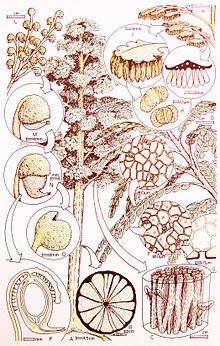Rank Family | Phylum †Pteridospermophyta Order Peltaspermales | |
 | ||
Similar Corystospermales, Umkomasia, Dicroidium, Lyginopteridaceae, Peltaspermales | ||
Corystospermaceae is a natural family of seed ferns (Pteridospermophyta) also called Umkomasiaceae, and first based on fossils collected by Hamshaw Thomas from the Burnera Waterfall locality near the Umkomaas River of South Africa The leaves of Dicroidium were recognized by Alex Du Toit to unite all the countries of the Gondwana supercontinent during the Triassic: Africa, South America, India, and Australia. Subsequently Dicroidium was found in the Triassic of Antarctica and New Zealand, and also the Permian of Jordan. According to the form generic system of paleobotany, leaves are given separate generic names to ovulate and pollen organs, but the discovery of these reproductive organs in Africa by Thomas, and subsequently throughout Gondwana, strengthened Du Toit's concept of a continuous southern supercontinent.
Description
Umkomasiaceae have helmet-like cupules around ovules born in complex large branching structures (Umkomasia). The pollen organ (Pteruchus) has numerous cigar-shaped pollen sacs hanging from epaulette-like blades, again in complex branching structures.
The leaves (Dicroidium) are tied to the fertile organs by similarities of cuticular structure, because their cuticles were robust like those of gymnosperms and unlike the thin leaves of ferns.
